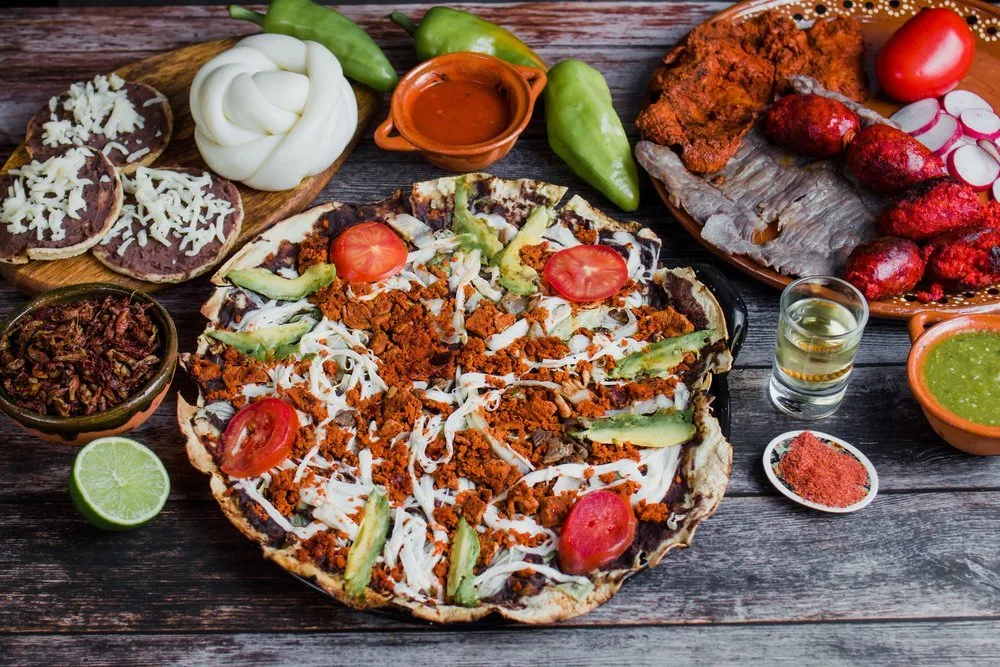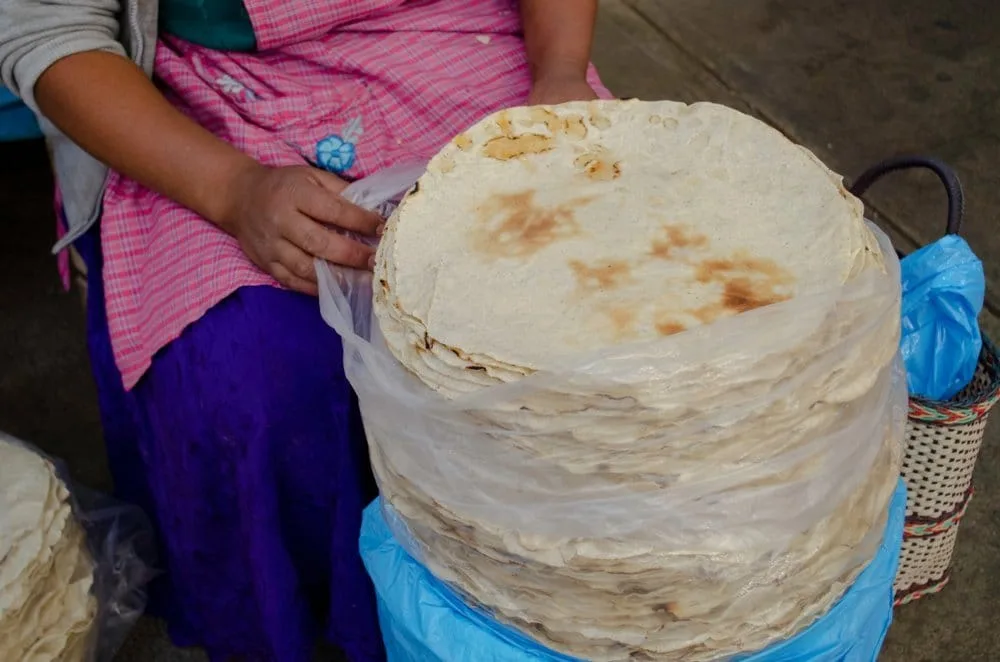Tlayudas: A Culinary Journey to Oaxaca’s Flavorful Tradition

Tlayudas: A Culinary Journey to Oaxaca’s Flavorful Tradition
The main ingredients of tlayudas include nixtamalized corn tortillas and Oaxaca cheese, and it’s the typical dish of the Central Valleys of the state of Oaxaca.
Its name comes from the Náhualtl “tlao-li,” which means “shelled corn,” and is complemented with the suffix “uda,” which refers to abundance.
Corn is a fundamental food in Mexican cuisine since ancient times. An enormous variety of dishes can be made due to the great diversity of available corn breeds.
Of the 64 corn breeds present in the country, 35 are found in Oaxaca, where a close relationship between indigenous groups and corn breeds has been developed.
Tlayudas are characterized by their large size, as each tortilla measures at least 30 centimeters in diameter.
Thus, the Zapotecos of the Central Valleys of Oaxaca is characterized by planting Bolita corn, a name given by the round shape of the cob and the grain.
Bolita corn has been pointed out as the specific breed with which tlayudas can be elaborated.
This is how it gets its characteristic semi-brittle texture, acquiring a better consistency, quality, flavor, and smell compared to those elaborated with any other corn.
What do Tlayudas taste like?

Its flavor differs from any other tortilla because, when toasted in a clay comal, it acquires a consistency that goes from flexible to semi-brittle without actually being toasted.
In addition, because it is cooked almost until toasted, it acquires an almost imperceptible aroma of burnt tortilla and makes the tlayuda last longer without decomposing compared to common tortillas.
Another advantage of the tlayuda is that it can be accompanied by practically anything.
Its basic ingredients are beans, quesillo, chopped cabbage, tomato, avocado, and delicious sauce.
Tlayudas are usually served with cesina or tasajo (a cut of beef, typically from the Central Valley of Oaxaca), but there are also delicious vegetarian options.
Again, tlayudas are served toasted to enjoy this incredible mix of flavors and smell in each crunchy bite.
Because of its gastronomic richness, the tlayuda was recently recognized as the favorite dish in Latin America through a social media competition organized by a famous digital platform.
Tlayuda production

But this is not the only recognition it has won. Since 2010, tlayudas have been part of the Oaxacan dishes that were declared Intangible Cultural Heritage by UNESCO.
The continuity in the elaboration and consumption of tlayudas speaks to us of their reinterpretation as a cultural food heritage.
In the context of globalization, tlayudas have become a strategic resource for economic development and represent food associated with the history, tradition, roots, and a process in which women are key.
Tlayudas are an important source of income for Oaxacan families.
The production of tlayudas is characterized as a work carried out exclusively by women.
Who use artisan techniques transferred from generation to generation since no machine can match the quality and presentation that the tlayuda acquires when handmade.
They are sold in communities, other parts of the country, and even the United States.
Tlayuda: Nutrients and Benefits
The tlayuda is a complete and balanced dish. Its ingredients are rich in fiber, vitamins, and minerals (vitamins A, B, C, and E, calcium, potassium, iodine, iron, and zinc).
The nixtamalized corn of the tlayuda contributes to a good proportion of complex carbohydrates and favors the bioavailability of calcium and niacin.
You will get the same amount of protein and fiber that would provide a similar portion of tortillas.
Beans are low in fat and cholesterol, and high in fiber, slow-absorption carbohydrates, and protein, which, together with the roasted tasajo, provide the greatest amount of protein in this dish.
Cabbage is an excellent source of fiber, vitamin A, B, and C, sulfur, calcium, nitrogen, and iodine.
Tomato is a good source of fiber, vitamin C, and potassium.
Its red color indicates that it contains beta-carotene, a form of vitamin A that provides great health benefits in the digestive, cardiovascular, and immune systems and many other vital functions.
The fat in avocado, being of vegetable origin, contains unsaturated fatty acids that protect against cardiovascular diseases, such as oleic acid and omega 3 & 6.
How much are Tlayudas?
Tlayudas can be found mainly in the markets of Oaxaca City.
However, it is pretty straightforward to find them in any Oaxacan restaurant in the country due to their popularity.
Their price may vary depending on the establishment and the ingredients.
A plain tlayuda tortilla ranges from 2 to 7 pesos, while a tlayuda with extra toppings can cost approximately 30 to 100 pesos.
If it’s prepared at home, it’s essential to have the right tortilla.
To purchase all its ingredients, which would yield at least five tlayudas, you would need approximately 100 and 200 pesos.
Depending on the amount and type of meat you want to use, it can even be prepared in its vegetarian version (I will show you below).
As I said earlier, tlayudas are delicious and healthy meals made from nixtamalized corn, black beans, and a mixture of vegetables.
However, you have to make sure that the amount of oil added during its preparation is minimal.
Also, ensure that you serve more vegetables than meat. This way, you get a complete and balanced meal.
Don’t wait any longer; give yourself the pleasure of eating a tlayuda, Latin America’s favorite dish.
Did you know?
In the San Antonio de la Cal municipality, on July 16, the traditional Tlayuda Fair is held as part of the Guelaguetza festivities, where you can enjoy this traditional Oaxacan dish.
Classic folded Tlayuda recipe:

Ingredients (4 servings):
- 4 tlayudas
- 2 cups of mashed beans
- 300 gms tasajo or grilled jerky in fajitas or small pieces
- 400 gms of shredded Oaxaca cheese
- 2 sliced avocados
- Sliced onion to taste
- Sliced tomato to taste
- Cabbage or lettuce to taste
- Sauce to taste
Preparation:
- Brown the tlayudas on the comal
- Cover the tlayudas with hot beans
- Place the tasajo or roasted jerky
- Add cabbage/lettuce, Oaxaca cheese, avocado, tomato, and onion
- Add salsa to taste
- You can serve it with radishes, guajes, pepitas, chapulines, or any other ingredient of your preference
- Enjoy
* You can use a little oil to heat the beans
Vegetarian Tlayuda recipe:
Ingredients (4 servings):
- 4 tlayudas
- 2 cups of mashed beans
- 1 cup chopped tomato
- 1 cup grated cheese
- 2 cups of diced jicama
- 4 tablespoons chopped onion
- 3 tablespoons olive oil
- 1 sliced serrano chile
For the guacamole:
- 2 avocados
- 1 serrano chile, chopped
- ¼ cup lime juice
- ½ cup chopped cilantro
Preparation:
- Blend the “guacamole” ingredients and season with salt and pepper
- Brown the tlayudas in a comal
- Cover the tlayudas with hot beans
- Mix the rest of the ingredients in a bowl
- Add the guacamole on top of the tlayudas
I hope you get a chance to try this delicious food if you haven’t already done so.
Oaxacan Tlayudas: Conclusion
In conclusion, the journey through Oaxaca’s flavorful tradition of tlayudas is nothing short of a culinary adventure.
From the bustling markets to the intimate family kitchens, every bite tells a story of history, culture, and passion.
The tlayuda embodies the essence of Oaxacan cuisine, offering a harmonious blend of textures and flavors that captivate the senses.
Whether enjoyed on a bustling street corner or savored in the comfort of home, this iconic dish serves as a gateway to the rich culinary heritage of Oaxaca.
So, next time you find yourself in Oaxaca, embark on your culinary journey and let the flavors of the tlayuda transport you to the heart of this vibrant region.






